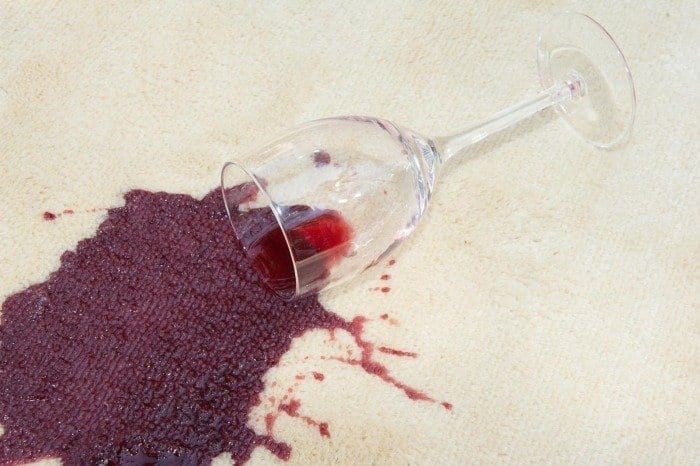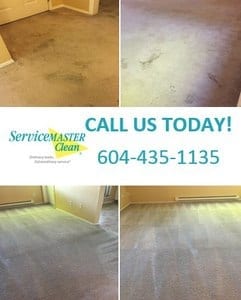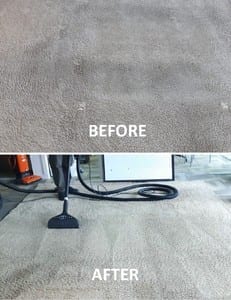You’re probably got a family party coming up, or just had one and dealing with the inevitable spots and spills that come afterwards. Not all spots require a call to a carpet cleaning company, and can be remediated effectively by yourself. Other stains must be acted upon immediately with a follow-up by a professional cleaner, or they will permanently stain the area. But which one is which? This article will help give you a sense of that.
The first step is to identify what the stain is, and its properties. Afterwards its to remove the discolouring from the outside of the carpet fibers before they can soak into its interior. The trick is to do so without harming the fabric.
So what kind of spots are there?
Water Soluble: Most spots are water soluble and will respond to water based cleaning solutions. This is why you find a wide variety of water based cleaning solutions. These tend to be the easiest to be to remove.
Non-Water Soluble: Most non-water soluble sots consist of oils, greases and pigments, etc. Some of these can be converted to water soluble form enabling water based solutions to be used. These tend to be harder to remove effectively without professional cleaning.
Non-Soluble: These cannot be dissolved with either wet or dry solvents. (example, wax.) With care and patience, these can be removed by oneself.
Combination Spots: Some spots are caused by substances that have both water soluble and non-water soluble characteristics. These spots require treatment of both water based and non-water based cleaners. Given their complexity, they require outside help.
Chemical Spots: These are spots that must be first chemically reacted before using water based or non-water based solvents. Examples: rust, medicines, urine, acids, alkalis, etc. These require immediate attention, first by you and then by a professional.
Destructive Stains: The staining material has altered the fibers’ physical properties. Most destructive stains cannot be removed. Examples: acids, bleaches, burns.
Dye Stains: This occurs when acid dyes are spilled onto carpet. They are actually dyes that replace the former color of the fiber.
Dye Loss: If a stain is lighter than the color of the carpet, some dye loss has occurred which means that cleaning will not solve the problem. Re-coloring is the best solution.
After identifying what you’re dealing with, and then you can use the appropriate product to try and remove the spot. Some, like destructive stains or dye stains may not be able to be removed. For those that can, read below.
Spot Removal Guide
The chart below is a guideline for spot removal. Follow each step in order, proceeding to the next step only if the previous step failed to remove the stain. This is not a perfect science: there are no guarantees that the approach will work. For one, the chemistry may not align properly. Our technicians are trained and have years of experience to diagnose each situation accurately and identify the best course of actions. They also have a much wider array of equipment available to deal with the situation.
Spotting Solutions
1. Detergent Solution – Mix 1/4 teaspoon colorless mild detergent in 1 cup water.
2. Ammonia Solution – Mix 1 tablespoon clear household ammonia in ½ cup water.
3. Vinegar Solution – Mix 1/3 cup white household vinegar in 2/3 cup water.
4. Dry Cleaning Solvent – Apply isopropyl alcohol (standard rubbing alcohol) to clean cloth and blot. DO NOT apply directly on carpet.
5. Scrape away as much as possible with a spoon or dull knife. Then use product in the next step to further address the stain.
The chart below shows you which solutions to try based on what is causing the spot or stain.
| Spot/Stain | First Attempt | Second Attempt | Third Attempt |
| Beer | 1 | 3 | |
| Blood | 1 | 2 | |
| Butter or Margarine | 4 | 1 | |
| Candle Wax | 5,
then lay a towel or paper bag over top remaining wax, and iron it on medium heat, heating the wax and transferring to towel. |
||
| Chewing Gum | Harden gum with ice until brittle,
5 |
4 or use a commercial chewing gum remover | |
| Chocolate | 5 | 1 | 2 |
| Cocktails | 1 | 3 | |
| Coffee | 1 | 3 | |
| Cough Syrup | 1 | 2 | |
| Crayons | 5 | 4 | |
| Egg (raw) | Blot | 4 | 2 |
| Food Coloring | 1, until color no longer transfers to towel | 2 | |
| Fruit Juice | 1 | 2 | |
| Furniture Stain | 4 | ||
| Glue | 1 | 4 | |
| Gravy | 1 | 2 | |
| Greases | 5 | 4 | |
| Ice Cream | 1 | 2 | |
| Ink (ballpoint) | 4 | ||
| Ink (India) | 4 | ||
| Jam or Jelly | 1 | 2 | |
| Ketchup or Tomato Sauce | 1 | 2 | |
| Lipstick | 5 | 2 | |
| Mildew | 1 | 2 | |
| Milk | 1 | 2 | |
| Mucilage | 1 | 2 | |
| Mud | 5 | 1 | 2 |
| Mustard | 1 | 3 | |
| Nail Polish | 4 | Apply amyl acetate or nail polish remover to cloth and blot. PRETEST FIRST | |
| Oils | 4 | ||
| Paint (oil based) | 4 | ||
| Paint (water based) | 1 | ||
| Rubber Cement | Roll the glue off when it has hardened sufficiently | 4 | |
| Rust | Apply rust remover or warm oxalic acid solution for 10 – 15 minutes | 2 | |
| Shoe Polish | 4 | ||
| Soft Drinks | 1 | 2 | |
| Soot | 1 | 4 | |
| Tar & Asphalt | 5 | 4 | |
| Toothpaste | 5 | 3 | |
| Urine | Blot as much as possible if still wet | 1 | 3 |
| Vomit | Blot as much as possible if still wet | 1 | 2 |
| Wine | 1 | 3 |



